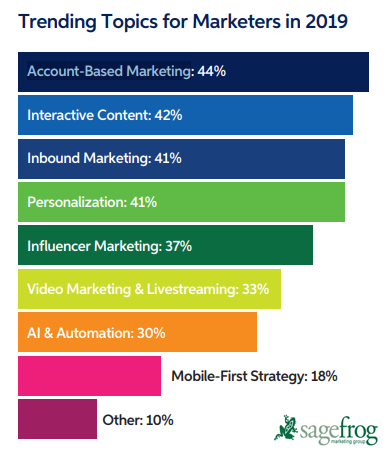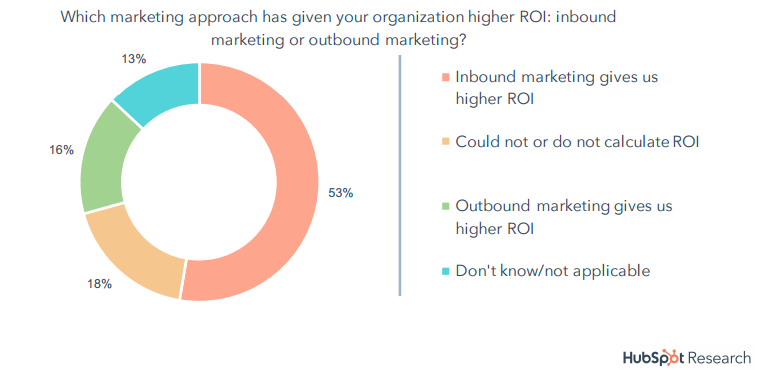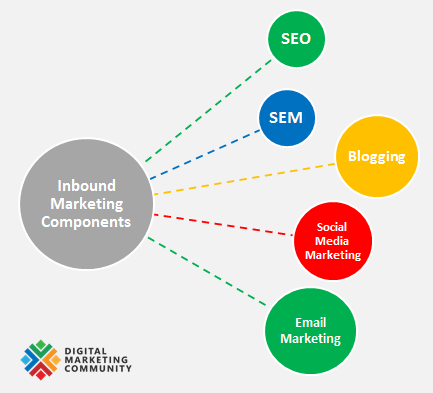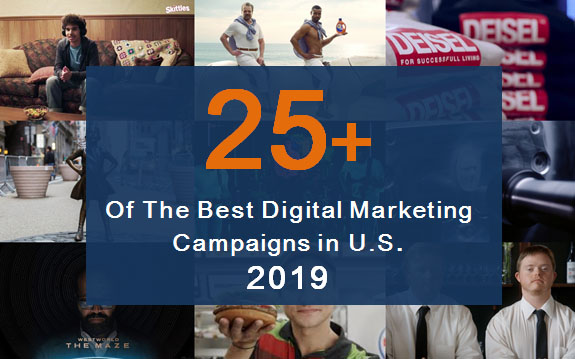What Are you Waiting for? Run Your First Inbound Marketing Campaign Now
Inbound Marketing | Mar 23, 2019
Consumer behavior has changed. Modern customers want to deal with companies that help and teach them before selling is even discussed. Marketing has made the shift, in turn, from PUSH to PULL.
That’s the concept of inbound marketing.
What Is Inbound Marketing?
Inbound marketing is a marketing strategy that is designed to earn prospects and customers to your website and blog, to make the company easy to be found through helpful content. Inbound marketing utilizes many forms of content marketing, blogs, events, SEO, social media and more – to create brand awareness and earn new business.
Unlike outbound marketing, where marketers fight to find customers, inbound marketing acquires the attention of customers. By creating helpful content designed to address the needs of your ideal customers, you grab qualified prospects and build trust and credibility for your brand.
Inbound marketing—aka “pull marketing” has proven much more effective than traditional outbound, or “push marketing” tactics. It’s considered one of the top three hot trends for B2B marketers in 2019, according to Sagefrog Marketing Group

A Figure Shows the Top Trending Topics for B2B Marketers in 2019
Inbound Marketing Model By HupSpot:
It’s clear that inbound marketing isn’t very different from your sales funnel. According to HubSpot, the company that coined the term “inbound marketing” in 2006, and consists of four main stages, Inbound marketing has served many companies well, especially in the startup world.
- The initial step in this process is all about attracting visitors to your website with compelling content. This may be a result of search engines’ search results or results of social media shares.
- The next step is to convert those visitors into qualified leads by means of call to action, lead generation forms, landing pages, and more.
- Finally, you should do your best to convert them into real paying customers by delivering on the value declared.
- And if you do a great job there, they may be turned to serve as advocates for your business/brand – fueling your startup’s growth.

Inbound Marketing Model by HubSpot
The Key Benefits of Inbound Marketing:
- It’s Cost-Effective:
Inbound marketing is the best choice for startups because the expense is typically low with a potential for high ROI, allowing startups to maximize marketing spend. This approach is all about reaching customers, connecting with them, and educating them, which is important for businesses that typically work in niche markets.
Higher ROI:
The ROI of inbound marketing is much higher than what is achieved by outbound marketing. It’s more targeted, more relevant and it goes out to people that need it. Given that prospects look for you when they need the product or service you offer, the sales closing rate is higher. According to HubSpot, inbound marketing is the most marketing approach that is giving organizations a higher ROI than outbound marketing.

The Top Marketing Approach That Gives Organization Higher ROI in 2018
Building Authority and Brand Awareness
By producing quality educational and entertaining content that is aligned with the buyer’s journey, your target audience will be able to find your information as they conduct their research. If you’re not out there, they won’t find you. It’s that simple. Furthermore, if they like what you’ve written, they’ll share and interact with your content – dramatically increasing your visibility and authority your reputation as a credible resource.
More Qualified Sales Leads:
I bet you asked yourself how does inbound marketing generate sales? Well, we can say that it generates relationships that lead to sales. Your valuable content will drive quality traffic and leads to your site.
So, the more frequently you produce content, the more often those potential customers are likely to visit your site – and when they do so, you’ll be ready for them with tactics like calls to actions, top-notch landing pages and content offers that will lead them to make their decision – thus, leading them down the path towards conversion.
HubSpot showed in its 2018 study on Inbound marketing that inbound marketing practices such as SEO, social media, content/blog, referrals, etc are the most sources that generate the highest quality leads.

Effective Sources That Provides the High-Quality Leads in 2018
The Ugly Face of Inbound Marketing – The Disadvantages:
- With inbound marketing, only the prospects that have chosen to view the message are reached, therefore limiting a campaign’s audience.
- The wealth of various kinds of inbound marketing content might overwhelm a prospect and cause a company’s content to get lost in the shuffle.
- Companies have less control over what a potential lead sees since he can look on the company website and may miss an opt-in offer that the company is trying to target him with.
- It takes longer to determine the return on investment (ROI) since prospects that come in might not be sales-ready at the time and will need additional nurturing to become customers.
- The two-way communication aspect can also backfire, with the spread of negative comments or bad reviews of a company, product or service.
The Main Components of Inbound Marketing:
There is no single inbound marketing technique that works well on its own. Inbound marketing can be thought off as a superset which involves a set of digital marketing disciplines. Some of these disciplines are:
- Search Engine Optimisation (SEO)
- Search Engine Marketing (including PPC)
- Social media marketing
- Blogging.
- Email marketing
These tools can be used in the different stages of inbound marketing and the most successful inbound marketing campaigns incorporate all or parts of the above elements.

The Key Components of Inbound Marketing
What It Takes to Start Inbound Marketing:
Thre are three main options o start inbound marketing depends on your goals, where your internal strengths lie and where you stand today:
- The “Do It Yourself” method.
- The “In Between” method.
- The “Do it For Me” method.
The first method will be the best choice if you have more time than money that you can do a few things yourself. In case you enjoy marketing or have someone on your team who is responsible for marketing activities, you probably are a good fit for the second method. And if you recognize that you need a team of experts dedicated to your online marketing efforts, you’re probably the best fit for the third method.
Tactics & Tips for Startups to Get Started With Inbound Marketing:
The goal of inbound marketing for startups is to attract more interested and qualified leads. There is a myriad of inbound marketing best practices that startups can use to get the lead-generation process started. Let’s review some handpicked tactics:
Create Your Target Persona(s)
It’s the initial and most important step in building an inbound marketing program. It gives you a deep understanding of what are your target audiences want to learn about, and why they’re interested in your product. Needless to say that, you’ll need to do some research to create your personas.
There are many ways to do your research, you can explore social media insights to craft your customer profiles and understand their demographics. You can also conduct some polls on your current customers using SurveyMonkey to ask them what they struggle with most and how they like to receive information around addressing these struggles.
Produce Outstanding & Free Content
After getting insights into what your target audience is and what they’re looking for, it’s time to create and share insightful and valuable content that your visitors can benefit from. Whether it’s in the form of blog posts, white papers, or ebooks. Keep in mind that you need to include other forms of media in your content and include stories in what you write.
It’s important to promote your free content by having (for example an exit pop up that showcases your free content or asks visitors to sign up for a newsletter). This would help you capturing leads for your business.
Write Compelling Headlines
You’re not the only one who writes content in a specific topic. The first thing that will differentiate you from other content writers and make users choose you without others is definitely the language you use to attract them. You should take all your time crafting a headline that appeals to your most targeted customers.
Leverage Blogs to the Fullest
Bogs is the best starting method to produce your content. According to SevenAtoms, companies who blog receive 97% more leads to their websites.
Start writing guest posts and write these posts consistently to provide you with backlinks, authority, and relationships with key influencers.
There is another great way to go, “Expert Roundups”.Have multiple industry thought-leaders answer industry-related questions in one blog post. Content like this can help build your own credibility in the domain.
Use Powerful & Clear Calls to Action (CTAs)
Every single piece of content should inspire your website’s visitors to take action. Check the outstanding HubSpot’s eBook “101 Examples of Effective Calls-to-Action” and choose from over 100 CTA real examples help you maximize conversion.
Sprinkle Some SEO Magic
The most important things here is to have basic on-page SEO knowledge and try getting backlinks for your website and your content. To do both, you need to optimize keywords on each page by finding some specific keywords which you’d like to use for targeting your content, then use them across your website in a natural way, without “stuffing” your words into the article.
The second and most important thing is to write content to build backlinks. Check this definitive guide produced by Backlinko to make the best of this factor.
Launch an Email Course
It’s a great way for startups to generate a lot of leads for your venture. The fact that email courses don’t cost any money and don’t require huge research or complex software on the backend.
Have Compelling Landing Pages
According to Google, landing pages are web pages that serve as the point of entry to a website or a section of it. The main goals from them are to encourage visitors to click, nurture them to buy, encourage them to give his/her permission for you to follow up, and get a visitor to learn something, or leave feedback.
Final Word
Inbound marketing works only if there is an endless stream of fresh, engaging, and valuable content to feed your highest-value customers. So, the overarching goal here is to be sticky to your analytics while still keeping your ear close to any upcoming trends and unknown variables that may arise.
And with these tactics, you should be primed for higher inbound success in 2019. My advice for you is to keep on innovating, experimenting and refining month to month, asset by asset.




